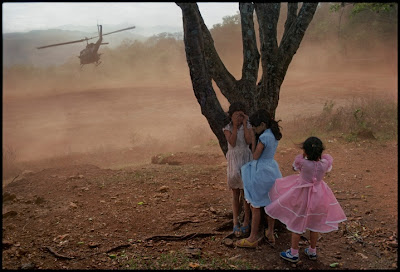my testimony. The events I have recorded should
not be forgotten and must not be repeated."
-James Nachtwey-
| James Nachtwey, Afghanistan, 1996. Woman mourning a brother killed by a Taliban rocket. |
Recently, on February 11, 2012, American war photographer James Nachtwey received the third Dresden International Peace Prize in Dresden, Germany--a leading city of European art and culture that was nearly completely destroyed on February 13, 1945, by Allied bombing. The prize was awarded and lauded by renowned German filmmaker Wim Wenders, who in his remarks said,
...It is the nature of war to engage and take in everything, to occupy and appropriate, without exception. Which war film, for example, isn’t, deep down, a glorification of war, even against better judgment, and often even in spite of the best intentions?
And: It is in the very nature of images to represent what they depict. “What you see is what you get.” That’s exactly what makes them so very powerful. It’s almost like trying to square the circle if you want to dissociate yourself from what an image presents and conveys, let alone try and tell the opposite of what it shows.
 |
Wenders continued:
War is a huge, infernal industry, the largest one on this planet. It seems presumptuous for one man to attempt to stand in the way of this machinery. Once war has broken out, everything spirals out of control almost immediately, turning even the armies and the soldiers who fight in it into helpless onlookers, victims of their own hubris.
Who would dare then to oppose it and put it into perspective with mere… photographs. Who would seriously deploy cameras against tanks? Just make the effort and visualize it for yourself!
| James Nachtwey, 2007. Photograph by Jaap Arriens, from Wikimedia Commons. |
After all, almost all of us take pictures today. Even your cell phones don’t come without a camera any more. Or perhaps you have one of those small, convenient digital devices. Or you may even own some professional equipment… Just imagine going to war with that! And imagine doing so just to take a picture to undeceive the entire world and tell them what’s going on there.
Yes: a photo that would influence the outcome of the war or even end it! Right. That would be sheer madness!
All right then, imagine just this: You want to change the life of ONE person with a photograph. That alone is an enormous challenge, if you think about it.
The short moment when you look through the viewfinder or at the tiny display, as you point the camera at something, and finally press the shutter button… that second is supposed to achieve something, to capture something and thus captivate, and thereby move somebody, or more so: even shake up the world?
How can that be possible? Who do you have to be to attempt such a thing? How… would you possibly go about it?
| Dresden, 1945 |
| Dresden, 1945 |
| Dresden, 1945. At least 25,000 people were killed in a single day during the Allied bombings. |
A Dresden press release reports:
In explaining the decision to award the Dresden Prize to James Nachtwey, Nobel Prize winner Guenter Blobel, President of the Friends of Dresden in New York and vice chairman of the Friends of Dresden Deutschland:
The prevention of violence is especially effective when a picture is conveyed of that which the violence of war is.
James Nachtwey is one of those who, without consideration of the danger to him- or herself, bring such pictures to us, pictures which we can never forget. And he does this as a moralist, as one who doesn’t merely hope, but rather believes that his pictures can change the way we think.
Without the photographs of Dresden in ruins, its destruction would have been long erased from the world’s memory and no longer a warning against armed conflict.
Through the photographs of James Nachtwey other wars remain in our thoughts.
Susan Sontag wrote: "Wars of which there are no pictures are forgotten."
And forgetting wars must not happen because then we forget their victims as well.
Photojournalists and documentary filmmakers who cover war and victims of injustice put themselves in danger's path every day to try to find and capture those images that might imprint themselves upon our collective conscience--that might make each of us stop, for a moment, from our busy lives and not only ponder the philosophical questions of morality and human responsibility but also, perhaps, to take some action.
What is it about an image, or a film, that can sear itself into our brains and continue to haunt us for the rest of our lives?
| Jeff Widener, Tienanmen Square, Beijing, China, June 5, 1989 |
How can we be moved to not only think to ourselves, "Never again," but to do whatever is in our power to champion nonviolence and promote peace?
How can a "mere" image change a life? What is the power of the visual image? What is the power of art, in general, to move our hearts, to touch our souls, to motivate us to speak and act in new ways?
No comments:
Post a Comment